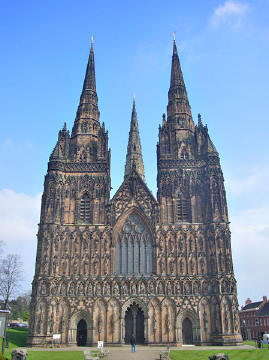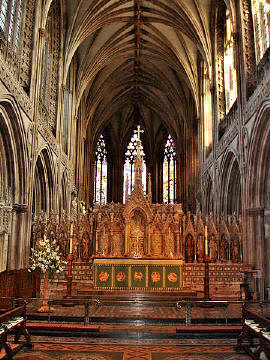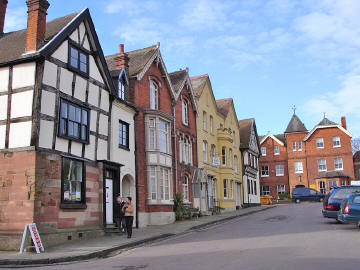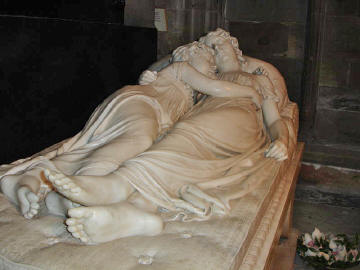Lichfield Cathedral
Lichfield , Staffordshire
|

Location Guide |
|

Picture By
Roger Robinson 
 |
Lichfield Cathedral was never a
monastery as most, but was established as a cathedral and has continued
with minimal interruption. It was not greatly affected by the
dissolution of the monasteries in the period of Henry VIII, and its only
severe problem was in the time of the civil war, when it was badly
damaged, and one of its three spires was felled. It is England's only
medieval Cathedral with three spires, Truro Cathedral, and the Episcopal
Cathedral in Edinburgh have three spires but both were built in the 19th
century.
The present building was started in
1195, and completed by the building of the Lady Chapel in the 1330s. It
replaced a Norman building begun in 1085 which had replaced one, or
possibly two, Saxon buildings from the seventh century. The Bishop's
Palace built in 1687 and a theological college built in 1837, are next
to the cathedral.
One of the smallest cathedrals it measures 113m (370ft) in length from inside the West Door to the extreme
end of the Lady Chapel. It is only 21m (68ft) wide. It is one of only
twelve surviving medieval chapter houses. The central spire is 77m
(252ft) high and the western spires about 58m (190ft) high. There are 113
statues on the West Front, but only four are medieval. The rest were
carved towards the end of the 19th century, as the original statues had
become very worn and most were removed in the 18th century. |
History
This site now occupied by the cathedral was
already a holy site, as the scene of martyrdoms during the Roman period. These
would have been Celtic Christians well ahead of the first Catholics arriving in
Britain. It is therefore likely that the site was occupied by several earlier
Celtic Christian churches ahead of being 'pack and wrapped' into the Catholic
faith. We know little about this, other than it being the reason for the
cathedral being on the site now. When Chad was made Bishop of Mercia in 669 he
moved his See from Repton to Lichfield, because it was a holy site, due to the
martyrdom that had occurred.
| The first Cathedral to be built on the
present site was in 700AD when Bishop Hedda built a new church to house
the bones of St Chad, which had become a sacred shrine to many pilgrims
when he died in 672. Offa, King of Mercia seemed to resent his own
bishops paying allegiance to the Archbishop of Canterbury in Kent who,
whilst under Offa's control, was not of his own kingdom of Mercia. Offa
therefore created his own archbishopric in Lichfield, who presided over
all the bishops from the Humber to the Thames. All this began in 786,
with the consent of Pope Adrian. The Pope’s official representatives
were received warmly by Offa and were present at the Council of Chelsea
(787), often called `the contentious synod', where it was proposed that
the Archbishopric of Canterbury be restricted in order to make way for
Offa's new archbishop. It was vehemently opposed, but Offa and the papal
representatives defeated Archbishop Jaenbert, installing Higbert as the
new Archbishop of Lichfield. Pope Adrian sent Higbert the pallium,
denoting his support for this move. In gratitude, Offa promised to send
an annual shipment of gold to the pope for alms and supplying the lights
in St. Peter's church in Rome. However, The Archbishopric of Lichfield
only lasted for 16 years, ending soon after Offa's death, when it was
restored to Archbishop Aethelheard of Canterbury.
Click on any small
image to see a larger version
|

 Image from wikipedia, edited to show more detail,
click here
Image from wikipedia, edited to show more detail,
click here
 to
see original. to
see original. |
Starting in 1085 and continuing through the
twelfth century the original wooden Saxon church was replaced by a Norman
Cathedral made from stone, and this was in turn replaced by the present Gothic
Cathedral begun in 1195. It was completed by the building of the Lady Chapel in
the 1330s. The Quire dates from 1200, the Transepts from 1220 to 1240 and the
Nave was started in 1260. The octagonal Chapter House, which was completed in
1249 and is one of the most beautiful parts of the Cathedral with some charming
stone carvings, houses an exhibition of the Cathedral's greatest treasure, the
Lichfield Gospels, an 8th century illuminated manuscript.
There were three sieges of Lichfield during
the period 1643-46 (civil War) as the Cathedral was surrounded by a ditch
and defensive walls, and made a natural fortress. The Royalists were
defeated in March 1643, and the Parliamentarians a month later. In 1646, the
Parliamentarians were once again victorious, but the Cathedral suffered
extensive damage, the central spire was demolished, the roofs ruined and all
the stained glass smashed. Today the windows of the Lady Chapel contain some
of the finest medieval Flemish painted glass in existence. It came from the
Abbey of Herkenrode, now in Belgium, in 1801, having been purchased by Brooke
Boothby, when that Abbey was dissolved during the Napoleonic Wars. It was
then sold on to the Cathedral for the same price. It dates from the 1530s.
There are also some fine windows by Betton and Evans (1819), and many fine
late 19th century windows, particularly those by Charles Eamer Kempe.
Bishop Hacket was responsible for bringing
the building back into use after the Civil War, but the interior you see
now, particularly east of the Quire Screen, was the work of Sir George
Gilbert Scott who was Cathedral Architect from 1855 to 1878. He returned the
Cathedral to what he believed it would have looked like in the Middle Ages.
It is recognised as some of his finest work with the magnificent Quire
screen and gates made by Skidmore of Coventry, the beautiful Minton tiled
floor in the Quire, Presbytery and Sanctuary, and the High Altar Reredos
decorated with semi-precious stones from within the Diocese. The carved
figures were a later addition.
|

Cathedral close, main fine period
properties
 |

Sleeping children photo from
Wikipedia
 |
Lichfield Angel
In February 2003, an eighth century
sculpted panel of the Archangel Gabriel was discovered under the nave of the
Cathedral. The panel was broken into three parts but was still otherwise
intact and had traces of red pigment from the period. It was first unveiled
to the public in 2006, when visitor numbers to the Cathedral trebled. After
being taken to Birmingham for eighteen months for examination, it is now
exhibited in the Cathedral.
|
Location: Lichfield Cathedral, Lichfield,
Staffordshire |
|
Grid Reference:
SK115097 |
Ceremonial County:
Staffordshire |
|
Map Link:
Multimap

|
Aerial photo:
Multimap
 Google (good)
Google (good) |
|
Getting there: Lichfield is 17 miles north
east of Birmingham near to the M42. |
|
Access: |
Website: Own
 |
Other Useful Websites:
wiki
 |
|
Email: |
|
Address: 19A The Close, Lichfield,
Staffordshire |
|
Postcode: WS13 7LD |
Telephone: 01543 306100 |
|
Opening Times: every day from
7.30am until
6.15pm. In the summer months
(Easter to September) it remains open until 7.00pm on Saturdays and
Sundays. |
|
Charges: No entry charge but donation
expected. They suggest £3.00 for adults. |
|
Nearby Locations: |
|
Other Location Pages:
List of all Anglican
cathedrals and other major Anglican churches in the UK

Abbey
section,
 including all major Christian buildings, regions orders, normal layouts and
history.
including all major Christian buildings, regions orders, normal layouts and
history. |
|
Notes:
No mention of photographic restrictions or
cost is on their website |
|
Page Ref: Lichfield_Cathedral |
Classification: Abbeys (incl. all Christian buildings) |
Date Updated: 09/2008 |
|

|
Please let us know any other information that we
can add to the Further information and Planning Grids or page and any errors that you discover. Before making a long trip to any location it is always
wise to double check the current information, websites like magazines may be
correct at the time the information is written, but things change and it is of
course impossible to double check all entries on a regular basis. If you have
any good photographs that you feel would improve the illustration of this page
then please let us have copies. In referring to this page it is helpful if you
quote the Page Ref and classification at the bottom of the Planning Grid above. To print the
planning grid select it then right click and print the selected area.
Please submit information on locations you discover so
that this system continues to grow.
|